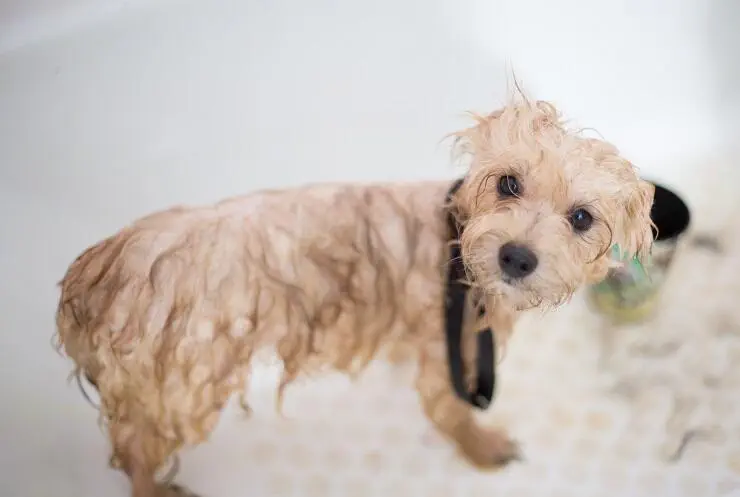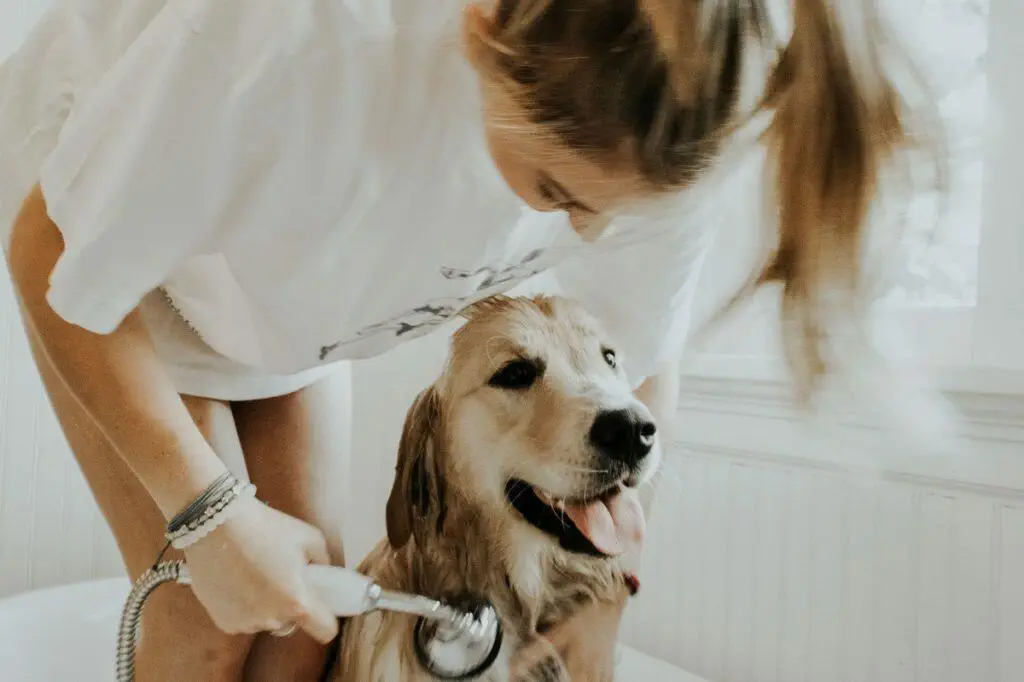It is something which has to be done. Mud, dirt, loose hair and even skin conditions or fleas can mean your dog needs a bath.
But even if you have a dog who loves going in the sea, rivers and lakes, they may not like being lifted up and put in the bath before being covered in shampoo. They may struggle to stay still long enough for you to clean them. You may also think you’re overwhelming them if you get other family members involved.
So, how do you properly bathe your dog? What are the basics? And what do you do if you have a dog who hates being bathed?
What do I need to bathe my dog?
First of all, you need to be prepared. It will only add to the stress for both of you if they are in the bath and you realise you don’t have everything you need.
When giving your dog a bath, you will need:
- A suitable bathtub (indoor baths, kitchen sinks for toy breeds, or an outdoor tub will suffice)
- Lukewarm water (it should never be too hot or cold, due to shock)
- Dog shampoo
- A grooming comb (waterproof is best)
- A lick mat (if your dog needs to be distracted) – more on this later
- A towel (dog microfibre towels will do the best job)
- Treats for afterwards
You may want to remove anything from the bathroom which could get wet if they shake, such as your own towels or plants. Bear in mind you may need to mop up the splashes!
If your bath is slippy and you’re concerned they could injure themselves, buy a non-slip bath mat. A hair trap for the bath plug may also be handy if you don’t want clogged drains.
You should also wear some clothing which you don’t mind getting wet. It may even be easier if you get into the tub with them, so you can wear shorts.
How often should I bathe my dog?
The answer is that it depends on your lifestyle, dog’s breed and environment.
It is the big question many people ask themselves before bathing their dog. Some say that you should wash your dog twice per year so they don’t lose the natural oils in their coat. Some people wash their dog every week, after muddy walks.
Many dogs will be fine with a bath every month. But if your dog is a mud magnet, and has white fluffy fur, you’ll likely need to wash them as much as once per week.
Breeds with oily coats, such as Bassett Hounds, may need to be washed more frequently. Dogs such as Pugs or Bulldogs may also need more frequent washes, to ensure all the skin folds are cleaned.
But too much bathing can really dry out your dog’s skin and remove natural oils that keep their skin healthy. There really can be a fine balance between bathing enough and overbathing.
You may wish to use your gut feeling on whether they need a bath or not, and know when to limit them. You know your dog best. But if in doubt, ask your vet or groomer.
If they get muddy on every single walk, you may simply need to change up their walking routes in winter or when it has been raining.

How do I wash my dog?
Giving a dog a bath sounds like it would be straightforward. However, it can get tricky depending on their behaviour, size, temperament and whether or not they find it enjoyable. Some dogs may react with nerves, and others may simply be hard to keep in one place.
- Before you get started, you need to gather your supplies. The list above should be everything you need. Keep them close to where you will be bathing them
- Clear the immediate area. Washing your dog can be messy and wet, so you want to make your life as easy as possible for the clean-up afterwards
- Brush your dog. Use their regular brush here, whether this is a grooming mitt or soft bristles
- Get your dog to where they need to be so you can lift them into the tub. If they are nervous, try to be subtle – pretend you’re using the bathroom so they follow you if you know they will run a mile if they know they’re having a bath
- Wet their fur with lukewarm water. This prevents their skin from drying out, or them from overheating/suffering from shock from cold water. If your shower is temperamental, you may want to have a large jug or bucket of this ready
- Apply the shampoo and start to lather it in. Use a small amount of shampoo – the bottle should give you a guide. Be careful not to get any near their eyes
- Rinse all traces of shampoo off. Not only can leftover shampoo irritate their skin, but they may also lick it off which could be dangerous
- You may then want to repeat the process if they’re particularly dirty, but be sure not to over-wash them
- Dry them using a towel. Try to do this when they’re still in the bathtub to minimise their risk of shaking the water off themselves! If your dog has long hair or skin folds, ensure all parts are dry
- Don’t let them outside for a while if it is cold (or you think they could roll in the mud to get themselves dry!)
My dog hates baths – how can I make it easier?
Dogs can love to go into rivers, lakes or other bodies of water, then hate baths. Why? Goodness knows!
Not to worry if your dog hates baths, though – there is plenty that can be done.
A lick mat could be enough to keep them occupied. Spread it with dog-safe peanut butter, and they will hopefully spend their bathtime licking it clean rather than trying to make a run for it. It also acts as a reward.
Stay calm. You don’t want to shout or get stressed at your dog because this, in turn, gets them stressed and they will learn to hate baths. If you’re struggling to get them into the bathroom, leave it for a while. Go make a cup of tea and calmly sit on the sofa, so they become calm again.
Think about whether they really need a bath. Is it just their feet and legs that are muddy? A dog wipe, wet towel or something like a portable dog washer could suffice. We have a list of non-bathing dog cleaning options.
You could try to make bathtimes fun. If they usually like water, a hose in the back garden could be turned into a game. Use tepid water though, and be sure not to do this when it is cold outside.
If all else fails, you may want to take them to a groomer for a bath every month or so. This could become expensive, but they may be able to give you some tips on how best to approach the scenario for those in-between washes.

Why does my dog hate the bath?
Asking yourself this could be key in actually helping your dog to learn to love bathtime.
Do they feel crowded and backed into a corner because the whole family are helping you bathe them? If they are too large to control yourself, stick to a maximum of two people who are calm and gentle. You may wish to pick their favourite human to help you. They can keep them calm while you do the washing.
Are they usually restrained? Physically holding them still, or using their collar and lead, could mean they feel like they can’t escape if they want to. Of course, allowing your dog to jump out of the bath mid-wash isn’t ideal either. But, try to be gentle. If they look like they are about to escape, switch your attention to getting them to stay.
Have they previously had an accident in the tub? Maybe they slip when in the bath, or they’ve had soap in their eye before. A non-slip mat, and a facecloth over their head to prevent water from going into their face, could help.
They may hate the feel or sound of the tap or showerhead. If so, fill a bucket or two of tepid water beforehand and use a jug. The good thing about this is actually that it will keep the water temperature consistent, so you’ll also avoid having to change the temperature when mid-bath.
You should also keep baths short. This may mean bathing them more often to keep your dog clean or utilising wipes and the garden hosepipe in-between times. A dog who doesn’t like baths won’t enjoy a bath taking half an hour.

